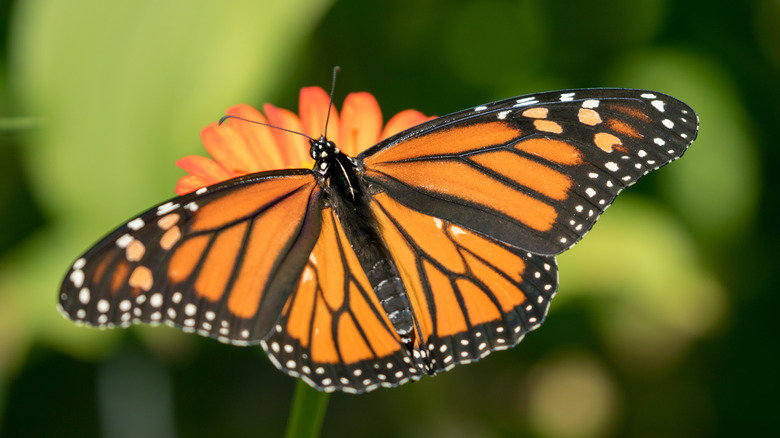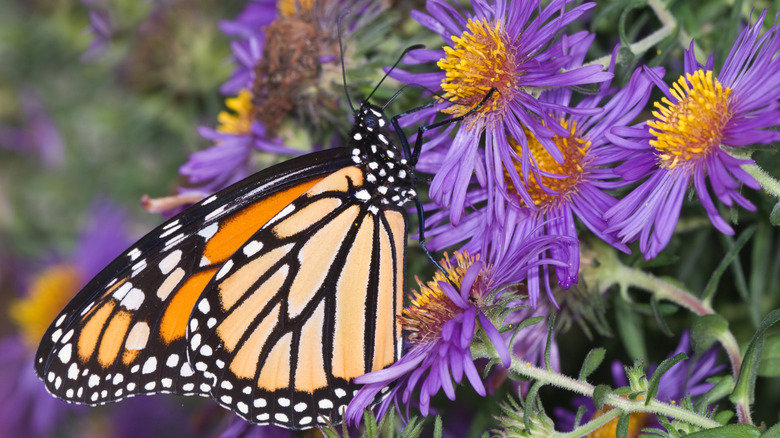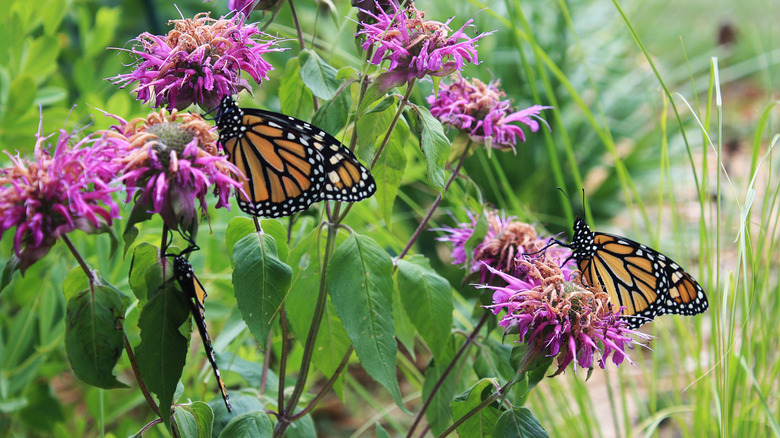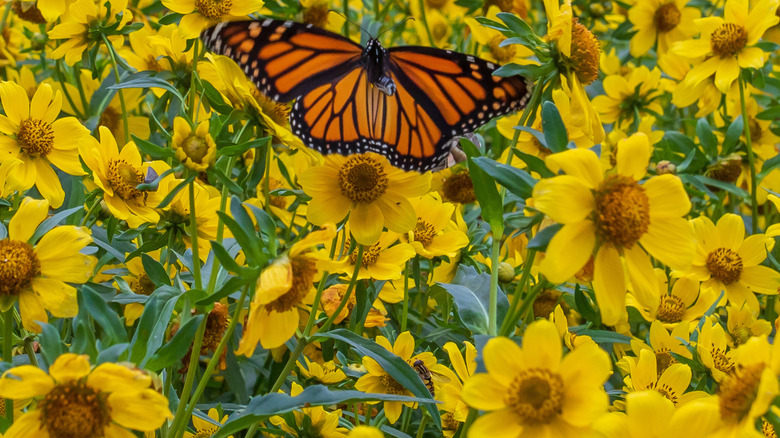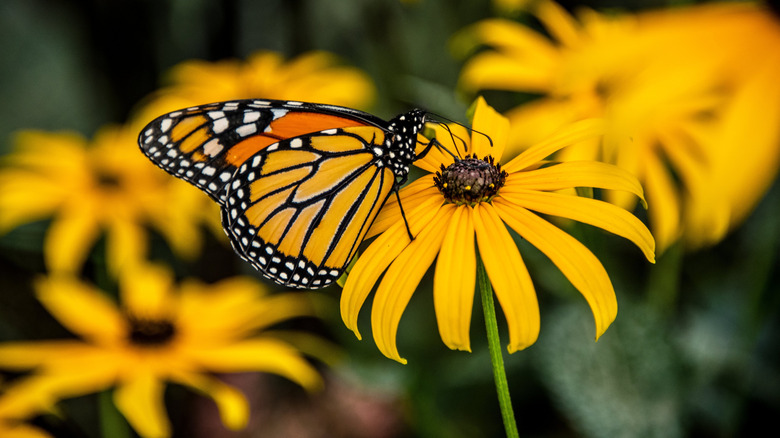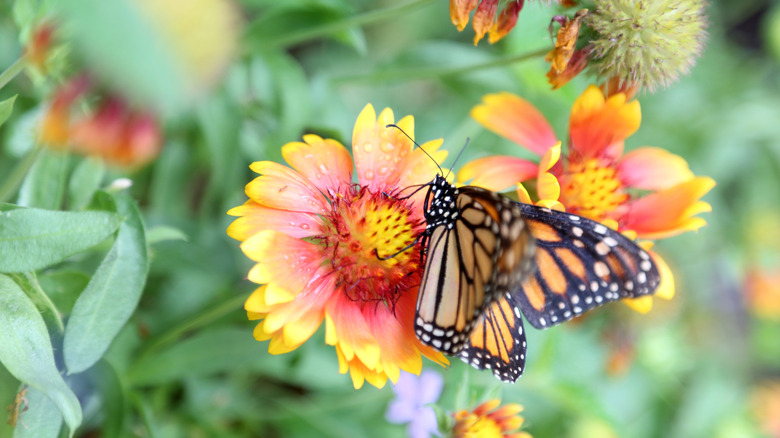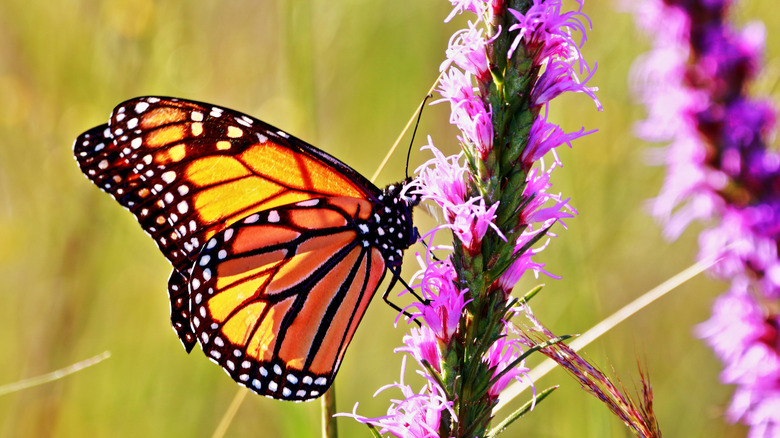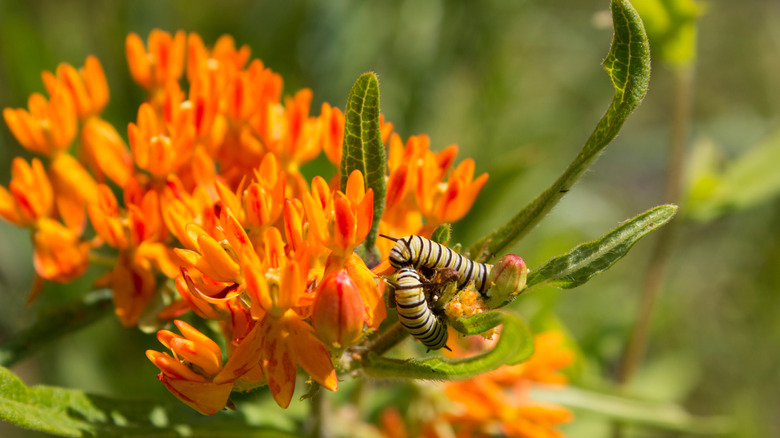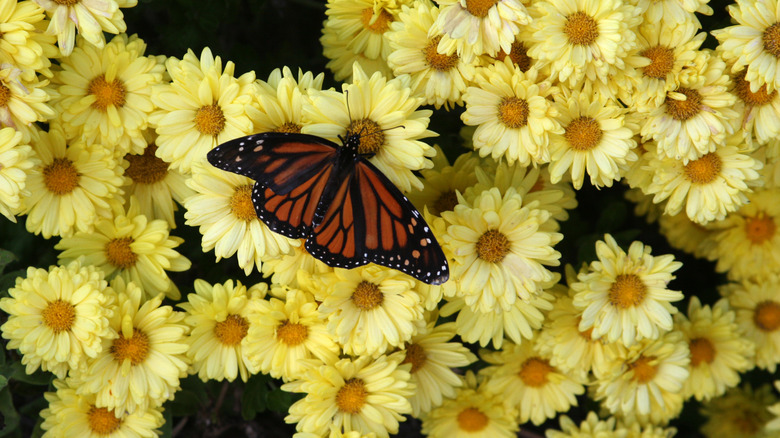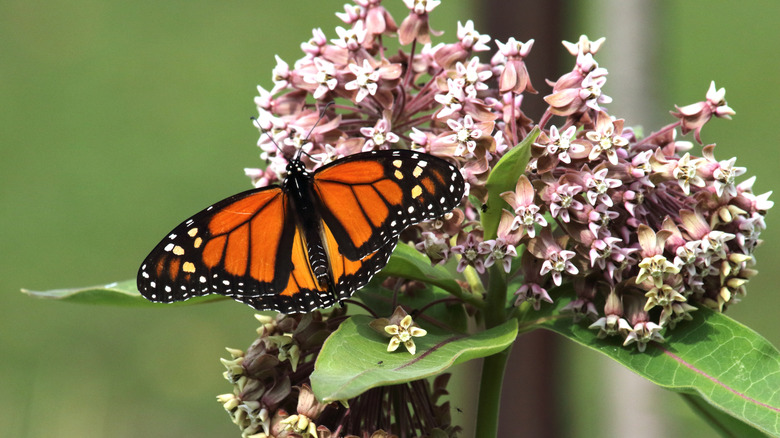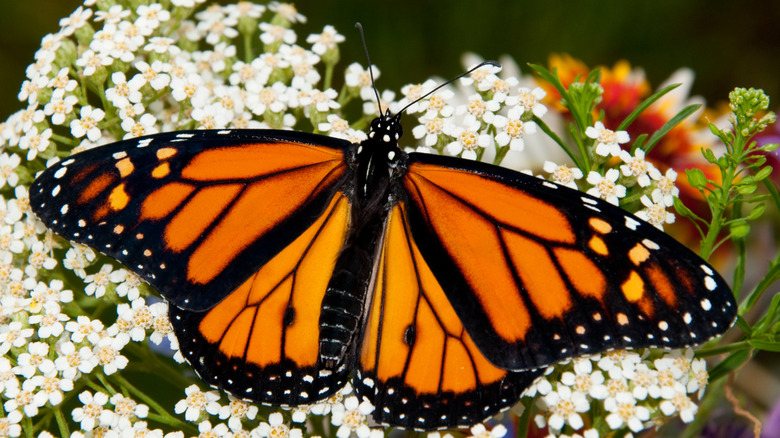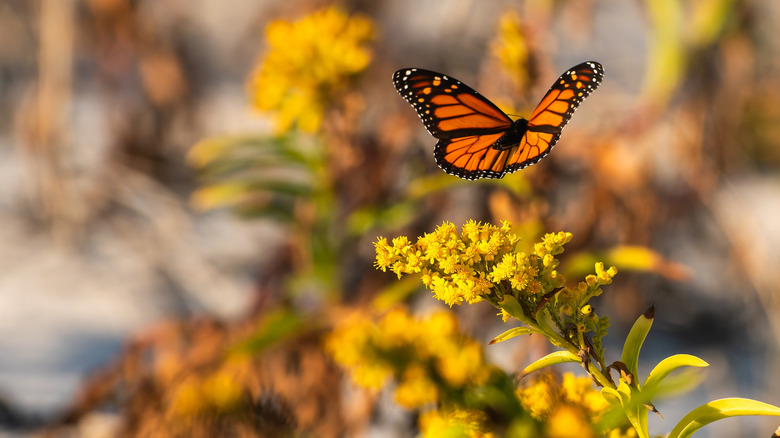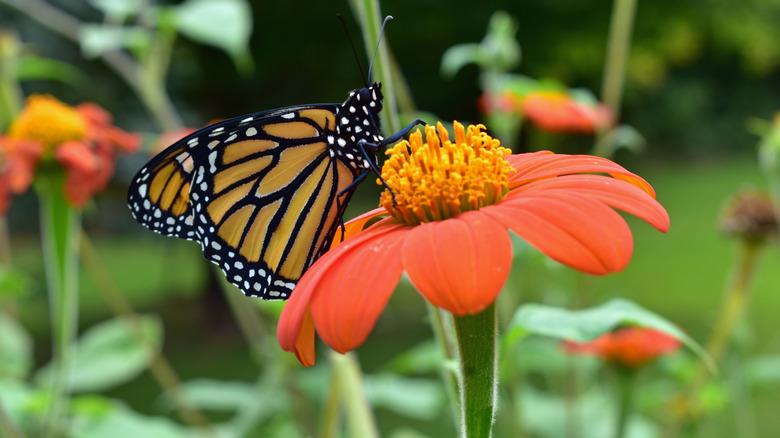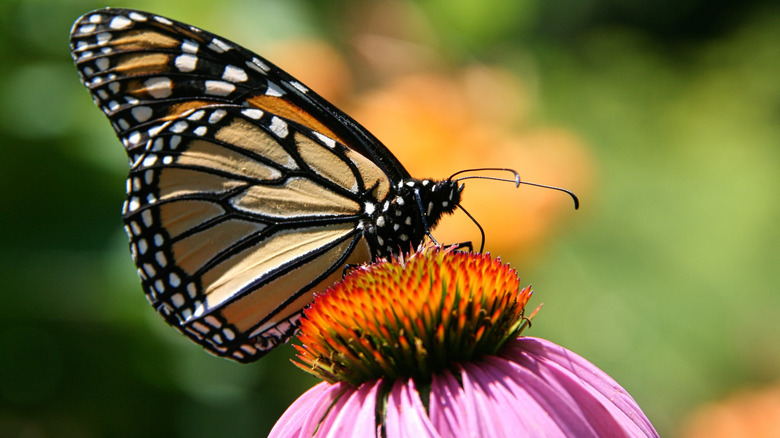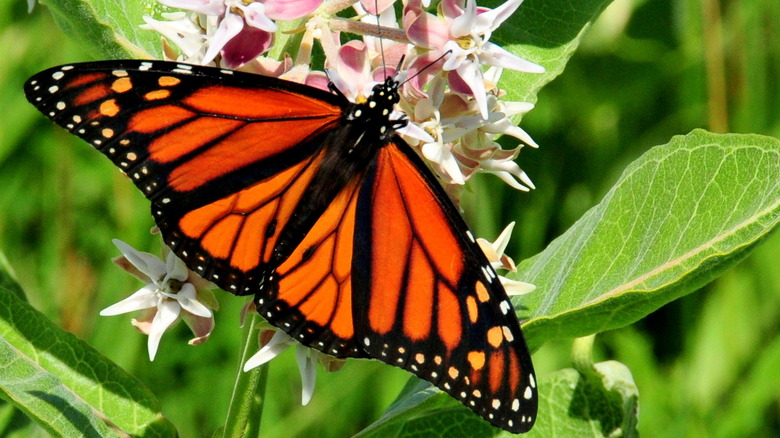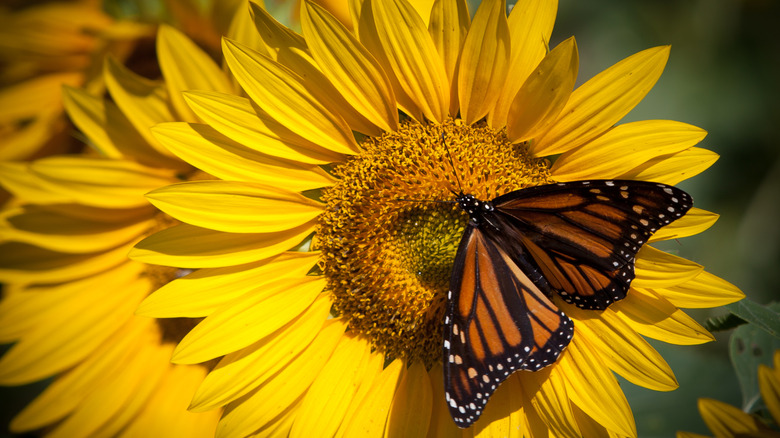The 15 Best Flowers To Attract Monarch Butterflies (And Brighten Up Your Yard)
With its charismatic appearance and awe-inspiring migrations, it's not surprising that the monarch butterfly motivates gardeners to provide extra care for these pollinators in their gardens. These butterflies are vulnerable due to habitat loss as well as other threats, so gardeners can help by adding monarch-friendly flowers to their yards and gardens. Keep in mind that whatever types of flowers you offer this pollinator royalty, you should be careful to avoid plants tainted with neonicotinoids, which are toxic to these and other pollinators.
In addition to a safe habitat free from harmful pesticides, these butterflies require food sources, and well-selected flowers can provide just that. Monarchs need flower nectar when they are adult butterflies, but they also require host plants for laying eggs and for caterpillars to feed on before their transformation into beautiful, winged insects. Once you've found a safe source of plants or seeds, you'll be ready to make your selection. And if you aim to attract monarch butterflies to your garden, you'll want to offer them a diverse selection of plants so that there is plenty for them to eat from spring through fall.
Asters
There are many different types of asters , and these flowers are key among the plants that will fill your garden with a variety of butterflies. Asters' daisy-like flowers usually have purple, blue, pink, or white petals, and yellow or white centers, providing welcome pops of color in the yard. Blooming in summer and autumn, these perennials are a great source of nectar for monarch butterflies as they migrate in fall.
Bee balm
With globe-shaped flower heads covered with tubular blooms in lilac or red colors, bee balms (Monarda spp.) are perennial plants that add eye-catching colors and shapes to the yard. Their fragrant flowers bloom in spring and summer, offering an excellent source of food for monarch butterflies and other long-tongued pollinators, like hummingbirds and certain bees. As a bonus, the leaves and flowers of these U.S. native plants can also be used to make herbal teas.
Beggarticks
While not well-known among gardeners, beggarticks (Bidens spp.) flowers are highly popular among monarch butterflies. There are many beggarticks species that are native to the United States. With white or yellow blooms and gold centers, these annual or perennial wildflowers provide a welcome food source for monarch butterflies during their autumn migrations, and offer gardeners a cheery farewell to summer in their yards.
Black-eyed Susan
Gardeners who want to grow mounds of bright yellow flowers fast can reach for Black-eyed Susans (Rudbeckia hirta). Bearing yellow flowers with brown to green centers, these U.S. native plants are biennials or short-lived perennials that will create a warm presence in the yard. And monarch butterflies aren't the only pollinators who love their spring and summer blooms– these cheery flowers will also draw in birds to forage from their seeds.
Blanketflower
With distinctive wheel-shaped blooms, blanketflower (Gaillardia aristata) produces flowers with red centers and yellow petals. Many varieties of this species also have a ring of red on the petals. These perennial flowers bloom in spring and summer and are native primarily to the northwest and north central regions of the U.S., as well as central to western Canada. Blanketflowers bring warm, bright colors to flower beds while providing forage for monarch butterflies.
Blazing star
Blazing stars (Liatris spp.) are members of a genus known for their vertical spikes of feathery purple, pink, or white flowers. The showy flower heads of these perennials catch the eye as they brighten up the summer landscape. Monarchs seek out blazing star blooms as a valuable source of food, and gardeners will sometimes spot multiple butterflies feeding from a single flower spike. There are many beautiful varieties of blazing star which will attract hummingbirds as well as butterflies.
Butterfly weed
With clusters of bright orange flowers, butterfly weed is a perennial that blooms in spring and summer. This type of milkweed, like other milkweeds, serves as a host plant for monarch caterpillars – cute little baby butterflies that need to eat milkweed foliage before they can take wing. This is the only orange milkweed flower recommended for monarchs in temperate zones because tropical milkweed can disrupt the migration of these pollinators.
Chrysanthemum
As autumn blooming flowers, members of the Chrysanthemum genus – also known as garden mums — can provide a welcome source of nectar for migrating monarchs. Whether you use them as annuals potted to create fall décor or plant them in the ground to come back next year, garden mums are available in a myriad of bright colors. Choose types where you can clearly see the yellow flower center for the most wildlife benefits because double blooms make it harder for pollinators to feed. Also, make sure you're purchasing pesticide-free plants from a reliable source.
Common milkweed
One of the most important monarch host flowers in North America, common milkweed (Asclepias syriaca) is native to the eastern and central US and Canada. Common milkweed is a perennial with big, rounded flower heads covered in soft pink blooms that appear in summer. This monarch host plant provides food for monarch butterflies as well as their babies, and its big balls of blooms will create a gentle glow in your yard, while reminding you of the wildlife help you're providing.
Common yarrow
Common yarrow (Achillea millefolium) is a perennial wildflower that has widespread origins across the Northern Hemisphere. The standard species has white or yellow flowers, but there are varieties and cultivars with a rich palette of blooms on offer. Blooming throughout the summer, common yarrow's umbrella shaped flowerheads provide landing pads for pollinators like monarchs, and are eye-catching in the flower bed or mini meadow.
Goldenrod
Perhaps the ultimate autumn blooming wildflower, goldenrods are loved by many pollinators, and a true boon for monarchs making their fall migrations. Goldenrods (Solidago spp.) are perennial plants that bear brightly colored sprays of yellow flowers, and tend to spread vigorously, which means that goldenrod colonies provide a banquet of food for butterflies. There are native species of goldenrod for every region in North America, and choosing a locally-adapted type will help ensure it is blooming at the right time for those orange winged fliers. The gold blooms of these wildflowers will give your landscape the Midas touch.
Mexican sunflower
With red-to-orange flowers on tall branching stems, Mexican sunflowers (Tithonia rotundifolia) are grown as annuals in flower beds or pollinator gardens. Their eye-catching, daisy-like flowers create a display of fiery colors from mid-summer to autumn, providing a long-lasting source of nectar for monarchs and other pollinators. And if you grow these beautiful plants in your yard, you'll be able to witness songbird magic happening as well.
Purple coneflower
While many types of coneflowers provide valuable food resources for monarchs, purple coneflowers are perhaps the most well-known coneflowers among gardeners, and are loved for their large, mounded, orangish centers surrounded by long, purple petals. These perennials bloom in summer, attracting everyone's favorite orange butterflies. Meanwhile these large flowers draw the eye with their contrasting colors, making a focal point in the yard.
Showy milkweed
A milkweed that gardeners in western North America can rely on, showy milkweed (Asclepias speciosa) produces large, rounded flower heads covered with muted pinkish blooms that seem to glow in the landscape. This summer bloomer will come back year after year, providing both a source of food to monarch butterflies, as well as nourishment for their young. There are many varieties of milkweed butterflies absolutely love — grow one or more that is native to your region for the greatest benefit.
Sunflower
While there are many different types of stunning sunflowers that will brighten your property — including perennials, annual common sunflowers (Helianthus annuus) are the most well-known, and they create a towering, cheery presence in the garden. With their huge yellow flowers, sunflowers are loved by a wide range of pollinators as a source of late summer and fall food. These flowers offer forage for migrating butterflies, as well as a host of native bees.
